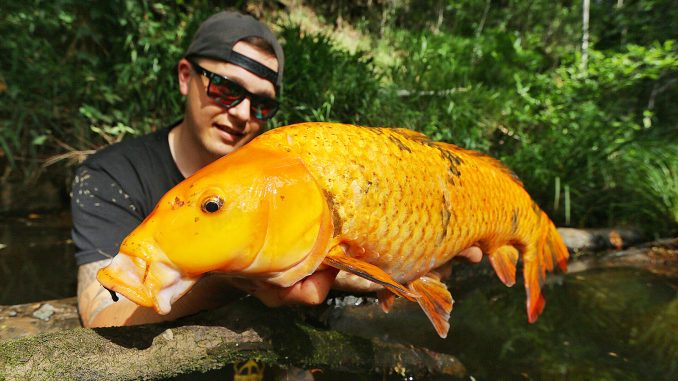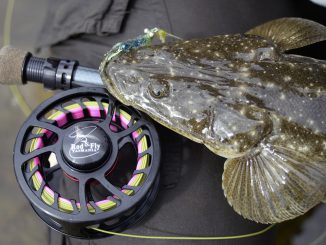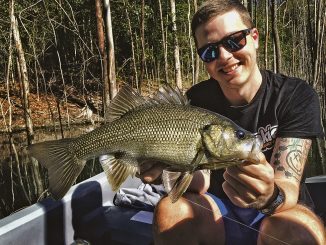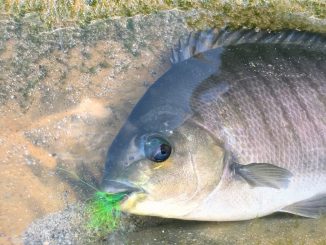
by Rupe •
A few of the early settlers of this great land have a lot to answer for. Beyond the mistreatment of traditional owners and land degradation, they’re also responsible for the introduction of some incredibly damaging flora and fauna species, not least of which is the carp.
Carp are not a problem that’s limited to Australian waterways. They’re now plentiful on every continent except Antarctica and while they’re a valuable commodity in Europe and Asia (depending on the genetic strain), they are an absolute scourge to the Australian aquatic landscape.
The habitat destruction in the Murray-Darling basin alone is enough that their introduction should be remembered as a national disaster with its own public holiday where every man, woman and child is required to catch and kill at least one carp.
Vote 1 – Rupe Is Fishing Party!
So what can we do to help?
We can catch them, dispose of them, and limit their breeding capabilities without leaving literally millions of tons of rotting fish in the water that could lead to a dreaded black water type event. You know what, they’re bloody fun to catch!
I’ve phoned around and had a chat to a few state fisheries offices when penning this article and the general consensus is to catch and dispose of as many as you can, particularly the larger breeding stock. They produce a huge amount of offspring in no time at all, so each breeder you can remove can make a big difference.
What you need to know about carp
As a species, they’re extremely adaptable to all types of waterways and water conditions (which is why they’re so wide spread) and they breed like rabbits. They’re also very mobile and not too territorial so will move up and down a river with ease, even in times when water levels are low and they might have to get their backs out of the water to move up a rapid.
No matter the particular species of carp, of which there are many, a few things remain constant: they are clever, they have excellent eyesight and they seem to spend most of their time on the lookout doing their best to avoid any trouble.
Even the plain brown models are still relatively brightly coloured compared to naturally occurring species and would make easy targets for large birds of prey, so you can understand why their existence would be a nervous one, and that’s before you take into account the natives swimming in their vicinity – ie Murray cod – who are big enough to eat them.
Carp are omnivorous, meaning they’ll quite happily eat aquatic plants, but they do prefer a diet of insects, crayfish, shrimp and worms. For whatever reason, they’ve also taken quite a liking to corn kernels.
Pound for pound, they’re one of the hardest fighting freshwater fish you’re likely to encounter and employ just about every dirty tactic you’d expect from a filthy, noxious pest whose ancestors cut their teeth dodging monster muskies and the like.
So you want to be a carp superstar?
I hope by now I have you so pumped up that you’re furiously looking up the nearest infected waterway so your carp muster can begin. But there are a couple of things you need to decide before you head out in search of the villainous creatures.
While carp can be VERY fussy and an eternal source of frustration – especially when sight-casting to them – if they’re in the right mood though, they can also be caught one after the other if you present your offering in the right manner.
WHAT SHOULD YOU THROW?
As mentioned above, a carp’s typical diet can be quite varied and they’re pickier with food than my 8yo daughter some days; changing their minds on what they’ll eat and what they’ll flat out refuse. Plenty of times different schools of fish in different pools of the same river will have totally opposite requirements from you, the angler.
This means that any fisher wanting to actively target carp needs to have a reasonable amount of arrows in their quiver, so to speak. Because of their fickle nature, you’re going to want to be armed with as many different lures, flies, baits or a combination of all three if you don’t want to go home with the dreaded doughnut.
One thing I must stress is to not be discouraged by the first, second or even seventh and eighth refusals. They will eat something, eventually. You just need to stay in the game, stay hidden as best you can and keep casting. There will be times they will charge your offering with an open mouth and just as the nerve endings in your striking hand start to fire messages to your brain they will turn away. This is standard trash behaviour.
Baits
Soaking baits like worms, small crustaceans such as shrimp and crayfish offer you your best chance of success. If you can catch them in the same waterway that you’re fishing then you’ll do even better because you can guarantee they’ve eaten that variety before and they’ll be willing to do so again.
If you’re wanting to sit in a camp chair and sink a few tinnies while fishing, try fishing under a float. They’re good strike indicators and it keeps your bait off the bottom, usually giving you better hook up potential before they realise there’s a hook in there.
This is your best bet when fishing with kids too. The float is something for them to concentrate on, but by the time it bobs under the water the hooking part is already taken care of and they can just enjoy the bend in the rod.
I talk to my kids on the trip to the water and also after we’ve disposed of a carp so they have an understanding of what we’re doing and why it’s important. If you give them the knowledge now they’re sure to carry that with them on future adventures.
If walking the bank and casting at fish you can see is more appealing to you (I know it is for me) then forget the float and cast lightly weighted or even unweighted baits 1-1.5m in front of the fish. Leave some slack line so the bait sinks in a more natural fashion.
Lures
Many carp have been tricked into eating a lure intended for cod, bass and yellowbelly, and plenty of anglers with carp on the end of the line have been fooled into thinking they had the world record catch on before those big blubbery lips made their way to the surface.
They’ll eat any number of hardbodies, blades and vibes if you put it in the right place at the right time, but they are absolute suckers for a nice supple soft plastic in a worm, grub or craw pattern.
If you plan to throw lures at them, fish them fairly slow with plenty of pause after you hop it. Scent is also your friend; use a quality scent like SAX or Pro Cure that will last a while. Give them time to sniff it out and come over for a nibble.
Flies
Flyfishing can be very effective because you can present a small, natural looking fly and land it without too much disruption to the water. For a fish that has evolved heightened senses this extra advantage should not be sneezed at.
It’s also the most difficult because you need to either have enough space to feed a cast out or be able to competently roll cast in tight cover.
If you are planning on waving the wand around, take a mix of flies with you that closely resemble the natural baits I’ve listed above as best you can. Patterns like shrimp, nymphs, worms and leeches all catch fish and flies like glow-bugs will serve you well if they’re eating berries and seeds are falling from overhanging trees.
THE SETUPS
My favourite way to target them is undoubtedly on fly gear. My friends and I have had some epic days on the water fishing rivers and dams for a variety of carp species. But there’s more than one way to skin a cat and plenty of ways to catch a mud marlin.
Fly Fishing
We all use a range of fly rods and lines from 4WT to 8WT and in varying lengths. My current setup is a 4WT, 9ft G.Loomis Eastfork rod and Shimano Biocraft reel with an intermediate Rio line while a few of my mates use a 7’11” model Sage BASS II series, which is much easier to get around with in some of the jungle country you can find yourself in. If you’re buying a new setup, look for a reel with plenty of drag. You’re going to need it. Something like the Redington Behemoth series packs a solid punch without breaking the bank, so check them out.
As with most types of fishing, sometimes you have to go light to get the bite, so my typical tapered leader finishes with 8lb line, sometimes the carp’s eyes are so well trained that you’ll need to go down to a 4lb fluorocarbon leader to avoid casting too much of a shadow on the bottom. Naturally, while this can get you the eat you desire, it presents a new set of problems if they decide to shoot upstream and bury you in rocks, logs and reeds – and they will!
Conventional Tackle
If you plan to chase them on conventional tackle, most light-medium estuary type combos will do the trick for you, but aim for something with a fairly sensitive tip as the bites are more often than not, very subtle.
A 6’6”-7’6” rod and a 2500-3000 size reel would be ideal. Braid is fine to use but make sure you have a nice long fluorocarbon leader. Mainly, so it’s as close to invisible as you can get underwater, but also because it buys you a bit of time if they run you into timber or other underwater structure and gives you a little bit more shock absorption on a typical carp surging run. As I’ve already told you, they’re a dirty fighting lot and will pull out every trick they’ve got to win freedom.
TAKING OUT THE TRASH
So you’ve found some carp, grabbed a rod and headed out on a carp crusade. Before you know it you’ve managed to crack that particular day’s code or pattern and you’ve now got yourself a carp on the bank or in the boat. What do you do next?
Fisheries departments in every state and territory in Australia that has a carp population have their own policies and procedures in regards to carp but in most cases it’s a fairly simple policy. Humanely dispose of the animal and under no circumstances return it to the water – dead or alive.
Even though they’re a pest, it is still unethical to treat them inhumanely.
In NSW waters you are permitted to return your catch to the same waterway but it is encouraged that you do not whereas in QLD and VIC it is an absolute no-no to return them so be sure to get familiar with your own local rules and regulations.
I’ve seen a few people (definitely the minority) saying it’s ok to return them to non-flowing waterways but this is wrong. I carry a knife and a fish spike in my backpack at all times when chasing carp so that as soon as they hit the bank I usually grab the obligatory picture for the social networks I participate in and then they’re walked about 20 feet away from the water, killed quickly and before you know it I’m looking for the next Charlie who’s silly enough to eat my fly.
They’re almost the only fish I kill these days and in a weird way I still feel some remorse for doing it but I do think that each and every carp removed is a small step in the right direction in the care of our native species which I love so very much.
In most cases you are allowed to keep them for food (not my taste but whatever floats your boat) or fertilizer if you wish.
There are recipes online if you’re that way inclined – just don’t invite me around for the cook-up. I promise I’ll be busy that day.



